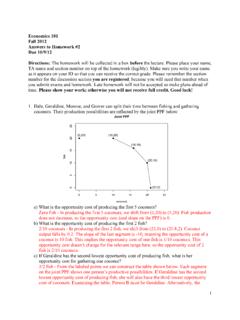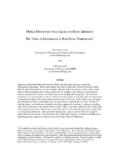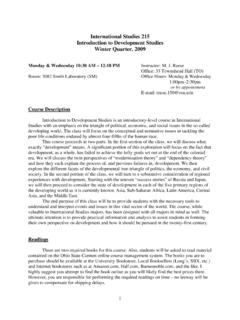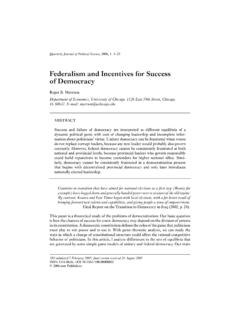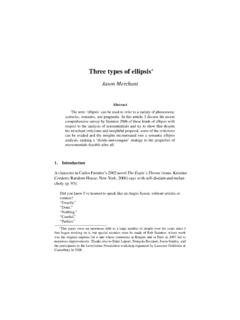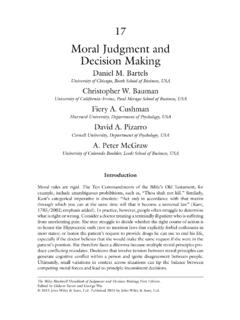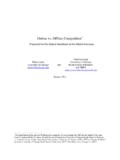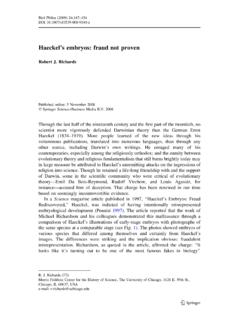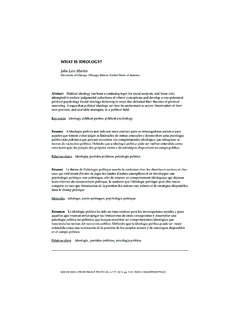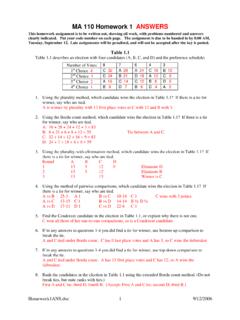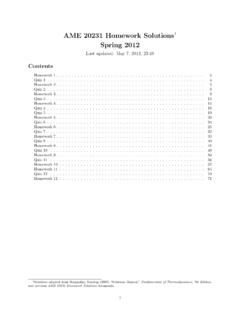Transcription of The homework will be collected in a box before you are ...
1 1 Economics 101 Fall 2012 answers to homework #2 Due 10/9/12 Directions: The homework will be collected in a box before the lecture. Please place your name, TA name and section number on top of the homework (legibly). Make sure you write your name as it appears on your ID so that you can receive the correct grade. Please remember the section number for the discussion section you are registered, because you will need that number when you submit exams and homework . Late homework will not be accepted so make plans ahead of time. Please show your work; otherwise you will not receive full credit.
2 Good luck! 1. Dale, Geraldine, Monroe, and Grover can split their time between fishing and gathering coconuts. Their production possibilities are reflected by the joint PPF below. a) What is the opportunity cost of producing the first 5 coconuts? Zero fish - In producing the first 5 coconuts, we shift from (0,20) to (5,20). Fish production does not decrease, so the opportunity cost (and slope on the PPF) is 0. b) What is the opportunity cost of producing the first 2 fish? 2/10 coconuts - In producing the first 2 fish, we shift from (21,0) to ( ,2). Coconut output falls by The slope of the last segment is -10, meaning the opportunity cost of a coconut is 10 fish.
3 This implies the opportunity cost of one fish is 1/10 coconuts. This opportunity cost doesn t change for the relevant range here, so the opportunity cost of 2 fish is 2/10 coconuts. c) If Geraldine has the second lowest opportunity cost of producing fish, what is her opportunity cost for gathering one coconut? 3/2 fish - From the labeled points we can construct the table shown below. Each segment on the joint PPF shows one person s productive possibilities. If Geraldine has the second lowest opportunity cost of producing fish, she will also have the third lowest opportunity cost of coconuts.
4 Examining the table, Person B must be Geraldine. Alternatively, the Alexander ClarkOpp costDale, Geraldine, Monroe, and Grover can split their time between fishing and gathering coconuts. Their production possibilities are reflected by the joint PPF ) What is the opportunity cost of producing the first 5 coconuts?b.) What is the opportunity cost of producing the first 2 fish?c.) If Geraldine has the second lowest opportunity cost of producing fish, what is her opportunity cost for gathering one coconut?d.) How many fish can Geraldine catch if she spends all of her time fishing?Answer: 05101520250510152025 Joint PPFcoconutsfish(0,20)(10,20)(16,16)(20,1 0)(21,0)2 person with the third lowest opportunity cost of coconuts will give us the segment between (16,16) and (20,10).
5 D) How many fish can Geraldine catch if she spends all of her time fishing? 6 fish 2. Nowhereland is an island economy with population of 4 Alice, Bob, Catherine and David. Everyday there are two survival activities under the northerly Sea of Ferocity: catching jellyfish and collecting seaweed. Both activities involve open water diving, requiring the use of an oxygen tank. Thus, a special kind of capital called oxygen tank is used in the production of these two goods. Each person possesses a different amount of oxygen tanks. The following table shows how many oxygen tanks each person has and how many are needed to produce each unit of the delicacies: Alice Bob Cathy David Oxygen Tank Possessed (Tanks) 6 10 8 15 Catching Jellyfish (Tank/Jellyfish) 1 2 2 5 Collecting Seaweed (Tank/Seaweed) 3 5 2 3 a) If everyone decides to catch jellyfish only, how many jellyfish can all of them produce?
6 If everyone decides to collect seaweed only, how many seaweed can all of them produce? If all decides to catch jellyfish Alice, Bob, Cathy and David will catch 6, 5, 4 and 3 jellyfishes, respectively or a total of 18 jellyfish. Similarly, if all decides to collect seaweed they will collect 2, 2, 4 and 5 seaweeds, respectively or a total of 15 seaweeds. b) What are the opportunity costs of catching jellyfish for each person? What are the opportunity costs of collecting seaweed for each person? Put your answers in the following table. Opportunity Cost for a Jellyfish Opportunity Cost for a Seaweed Alice Bob Cathy David The logic is as follows: Alice faces a tradeoff of either 6 jellyfishes and 0 seaweed or 0 jellyfish and 2 seaweeds.
7 Hence, for Alice, the opportunity cost of a jellyfish is 2/6 = seaweed/jellyfish (gives up 2 seaweeds for 6 jellyfishes) and the opportunity cost of a seaweed is 6/2 = 3 jellyfishes/seaweed (gives up 6 jellyfishes for 2 seaweeds). The similar logic applies to the rest of the population. Here s the completed table. 3 Opportunity Cost for a Jellyfish Opportunity Cost for a Seaweed Alice Seaweed/Jellyfish 3 Jellyfishes/Seaweed Bob Seaweed/Jellyfish Jellyfishes/Seaweed Cathy 1 Seaweed/Jellyfish 1 Jellyfish/Seaweed David Seaweed/Jellyfish Jellyfish/Seaweed c) Who has the absolute advantage in catching jellyfish/collecting seaweed?
8 Who has the comparative advantage in catching jellyfish/collecting seaweed? There is a catch here! (1) Note that the table gives the number of oxygen tanks required to complete a task, not the amount of task they can do. (2) Notice that each person has unequal amount of oxygen tanks. Hence, we need to normalize the amount of resources each person has, , assuming that each has an equal amount of resources, ask how many they can produce. Let s choose 60 tanks to equate the number of oxygen tanks each person has, so the following table shows how many jellyfishes and seaweeds can be caught and collected .
9 Alice Bob Cathy David Oxygen Tanks 6 10 = 60 10 6 = 60 8 = 60 15 4 = 60 Jellyfish Caught 6 10 = 60 5 6 = 30 4 = 30 3 4 = 12 Seaweed collected 2 10 = 20 2 6 = 12 4 = 30 5 4 = 20 With the same amount of resources, clearly Alice has the absolute advantage in catching jellyfish and Cathy has the absolute advantage in collecting seaweed. Using the table in part b), since Alice has the least opportunity cost of catching a jellyfish by forgoing only seaweed, she also has the comparative advantage in catching a jellyfish. Similarly, David has the least opportunity cost of collecting seaweed; thus, he has the comparative advantage in collecting seaweed.
10 D) Determine the acceptable range of trading price for 1 jellyfish in terms of number of seaweed. Determine the acceptable range of trading prices for 1 seaweed in terms of number of jellyfish. The acceptable range of trading price is the difference of the lowest and highest opportunity costs in doing something. Hence, the acceptable range of trading price for 1 jellyfish is between [ Seaweed, Seaweeds] and for 1 seaweed is between [ Jellyfish, 3 Jellyfishes]. e) Label Seaweed (S) and Jellyfish (J) on the x-axis and y-axis, respectively. Give the equations for the PPFs of each person and plot separately.
